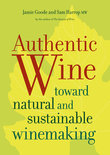Authentic Wine, by Jamie Goode and Sam Harrop MW
| Title of book: | Authentic wine: toward natural and sustainable winemaking |
| Author: | Jamie Goode and Sam Harrop MW |
| Publisher: | University of California Press |
| Publication date: | 2011 |
| ISBN | 978 0 520 26563 9 |
| Pages: | 259 |
| Price: | US$29.95 / £20.95 |
 I’d imagined this was going to be a book about natural wines under a slightly different name to draw us in. But the reader quickly grasps this book is about more than the narrow, ‘natural’, narrative. It embraces the broadest discussion of wines of place within a treatise around the various environmental issues affecting viticulture and winemaking, as the authors draw together current thinking on how a sense of place in wine is achieved, including the place natural wine has in that tapestry.
I’d imagined this was going to be a book about natural wines under a slightly different name to draw us in. But the reader quickly grasps this book is about more than the narrow, ‘natural’, narrative. It embraces the broadest discussion of wines of place within a treatise around the various environmental issues affecting viticulture and winemaking, as the authors draw together current thinking on how a sense of place in wine is achieved, including the place natural wine has in that tapestry.
It neatly brings together the different, sometime diffuse, strands of issues relating to the practice of increasing sustainability in wine-growing. It groups the various current initiatives in one place, and opens up for thought the major issues relating to improving the sustainability of the ways vines are grown and wines are made, arguing a connection to, and stewardship of, the land is vital to express terroir, or typicity. They argue the logical extension of this land stewardship carries on into the winery, where as few human interventions and manipulations as possible result in original wines. (Wo)man they argue (quite rightly to my view) is of course a necessary part of terroir expression – there is no “bubbling brook of Chablis” they write!
It opens up the discussion on terroir, on organics and biodynamics, and on yeasts’, ripeness’ and alcohol’s contribution to sense of place. It’s not until chapter 8 that the natural wine movement is opened up, after all the various winemaking interventions and manipulations have been outlined – the very things that the ‘natural winemaker’ seeks to minimise. Natural wines are a hugely opined topic of fashion in the wine industry, often with so much opinion and less substantiation, so it was good to read about the thoughtful origins of this movement in Beaujolais in the authors’ refreshing, dispassionate style.
Given the paucity of scientific evidence for so many terroir effects, the pair do well to emphasise their own beliefs and suppositions where science does not yet have an authoritative (authentic?) answer, for example, they summarise received wisdom about minerality (a subject close to my heart) and explore it via anecdote and experiential evidence, which is about all there is at the moment. On this basis, there are plenty of subjects raised in this book from which academic scientists might be able to build research projects.
Disappointingly the pictures are reproduced in black and white, which may be good for production costs, but it’s not necessarily great to identify what’s trying to be shown. A central series of pages of colour plates might have been preferable, especially as the images don’t always relate directly to specific bits of text.
The individual experiences of case studies give good anecdotes, such as Nigel Greening’s (Felton Road) use of goats, rather than herbicide spray, to keep thorn bushes at bay, which subsequently themselves become dinner. Or Frank Cornelissen (making wine on Mt Etna in Sicily) discussing the more extreme end of the natural/non-interventionist spectrum.
Packed in between all these topics are chunky, detailed sections on winemaking matters that inform the authors’ views, and gets readers up to speed on the facts around such things as manipulations, yeasts and faults. Who knew that Saccharamyces cerevisiae is a lurker that uses the creation of alcohol to beat off the yeast competition?
I’m intrigued that the authors advocate certification of sustainable practices but seem not to have the same view with regard to organics, biodynamics, or natural wine. In that all these approaches should form one segment of wider sustainability, I tend to think certification of any of the approaches is the only really measurable route towards that wider sustainability.
This book has me nodding my head in agreement and shaking it occasionally in latent debate all the way through – which probably means it’s hit the mark for the authors. It’s a persuasive read in a calm, eminently readable style which makes the complex subjects hugely approachable and comprehensible. Given the importance of these subjects, that is great work. I can envisage readily-thumbed volumes of this sitting on the bookshelves of wine enthusiasts and professionals alike.



